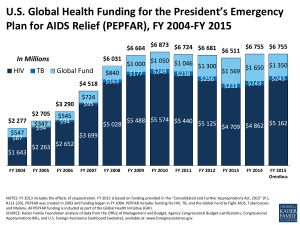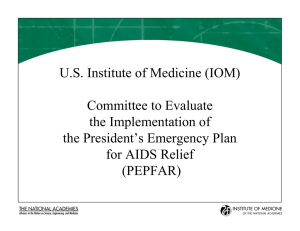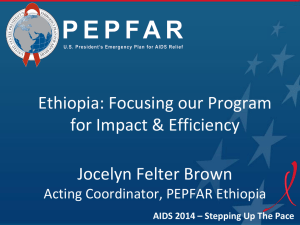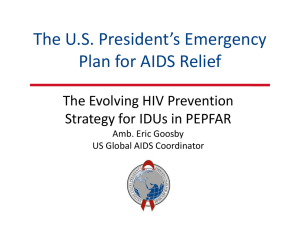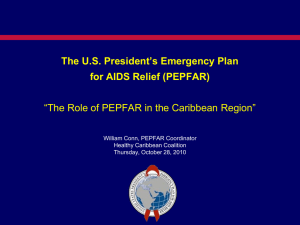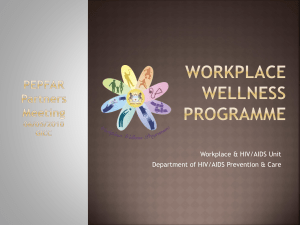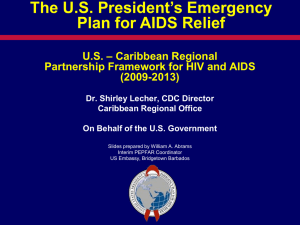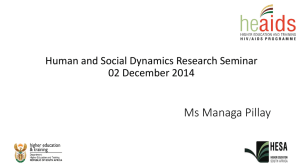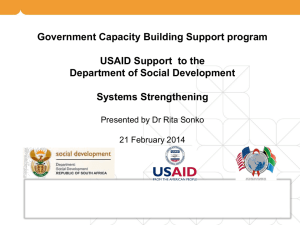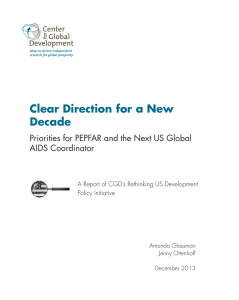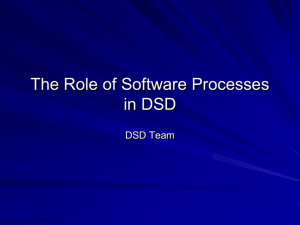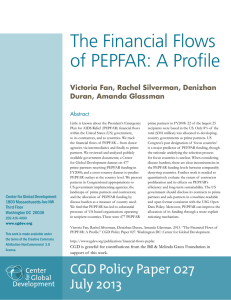OVC MandE meeting Feb 20
advertisement
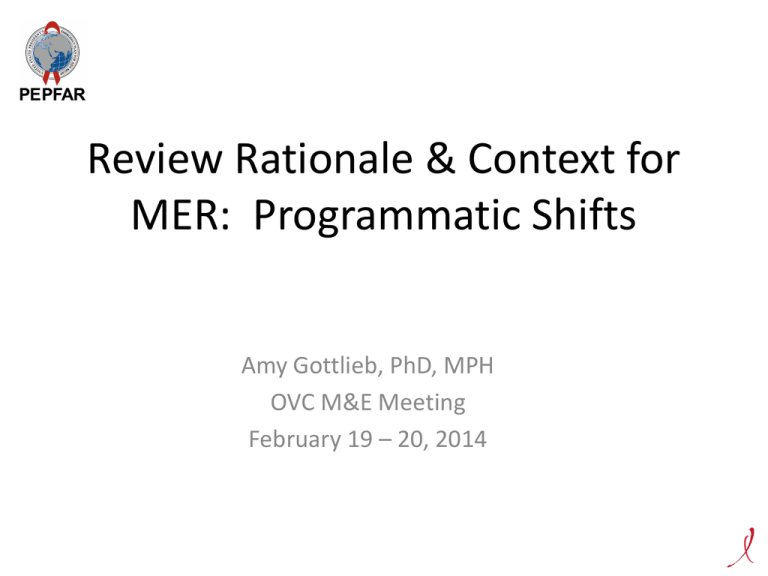
Review Rationale & Context for MER: Programmatic Shifts Amy Gottlieb, PhD, MPH OVC M&E Meeting February 19 – 20, 2014 PEPFAR Support – A View of the First 10 Years PEPFAR after 10 years, two phases • Emergency to sustainability • Increased collaboration with multilateral partners • Emphasizing contribution to national programs, alignment with national strategies, evidence based for national epidemics • Continued emphasis on results and efficiencies Phase I (FY04-FY08) driven by 2-7-10 • PEPFAR processes routinized and country teams formed • Reported on: Direct, Indirect, and Total • With many revisions in first five years • (e.g. Reduced burden of reporting) Phase II (FY09-FY13) driven by 3/6-12-12 • Reported on: Direct and National • Limited attention to policy, quality, capacity (lab), HSS (HRH) • Implementation in context of Partnership Frameworks with multilaterals, in support of national program Phase III (FY14-FY18) seeks to evolve how we describe PEPFAR support • Reporting on: Direct Service Delivery & Technical Assistance • Improved M&E of capacity, quality, country ownership, impact • Implementing in context of Country Health Partnerships to advance results and country ownership, in close collaboration with multilaterals 2 PEPFAR MER Introduction 2013_11_21 Background of Phase III • As part of the MER, an interagency task team was established to review the definition of ‘direct’ and provide guidance for FY14-18. • The task team proposed that PEPFAR should adhere to the historical intent of ‘direct’ while refining and clarifying its definition. • Field and TWGs provided input on revised definition. Definition was further clarified in response to their feedback. 3 Why Revise the Definition of “Direct” • To date, PEPFAR has counted individuals as ‘directly supported by PEPFAR’ using broad criteria, largely left to program areas and country teams to define. • As PEPFAR support evolves, we need a more rigorous and standardized definition of ‘direct support’. • As country capacity increases, PEPFAR support evolves in response, and PEPFAR results will change. • This revised definition acknowledges that not all PEPFAR efforts will count as ‘directly supported’. • This change is appropriate because it more accurately characterizes the nature of our support. 4 Defining “Direct Support” – Before and After Previous Updated • ‘Direct support’ is interpreted broadly • Definition is clarified • Refers largely to individuals • Few alternative indicators to document TA/capacity building to sites, organizations, communities, and health systems at various level. • New MER indicators allow focus on TA/capacity building and application of definition now allows teams to report these areas as ‘directly supported’ by PEPFAR • PEPFAR reporting helps ensure accountability at the agency level (i.e. help agencies manage implementing partner contracts & aggregate results at country level) • Same • Allows PEPFAR to report to internal stakeholders (OMB, Congress, etc) on program progress • Within the context of national results; retain ability to speak to program achievements 4 Revised Definition of PEPFAR Support More accurately describes PEPFAR’s evolving contributions in alignment with national HIV strategies and programs: • Refined definition of direct service delivery (DSD) support to individuals • Introduce definition of technical assistance (TA) support to sites and above sites • What is a ‘site’? ‘Site’ is a proxy for ‘points of service delivery’ and refers to health facilities, labs, communities, CBOs, school wards, and other such entities. • Above ‘site’ level includes support to districts, regions, and national government offices that is above the level of service delivery. 6 Revised Definition of PEPFAR Support Individual Level Individuals receiving HIV related services will be counted as receiving direct support for service delivery (DSD) from PEPFAR when the support: 1) is critical* to the delivery of the service to the counted individuals; AND 2) involves established presence at and/or routinized, frequent (at least quarterly) support to those services to those individuals at the point of service delivery. Both conditions must be met in order to count individuals as directly supported by PEPFAR. * “Critical support” is defined on an indicator by indicator basis 7 Examples of Critical Support & Established Presence (TA Support) by Indicator Indicator: Number of HIV-infected adults and children receiving ART Number of key populations reached with individual and/or small group level HIV preventive interventions that are based on evidence and/or meet the minimum standards required Critical Support: Commodities, human resource salary support. For ART this can include ongoing provision of critical re-occurring costs or commodities (such as ARVs) or funding of salaries or provision of Health Care Workers for ART clinic services. For example, procurement of condoms, salary of personnel providing any of these services (i.e. outreach workers, program manager), or program design i.e. the development of training curricula, prevention guidance development, or standard operating procedures (SOPs), & follow-up to ensure fidelity to the program design) TA - Established presence, routinized frequent (at least quarterly) support: For example, clinical mentoring and supportive supervision of staff at ART sites, Quality Improvement services support, patient tracking system support, routine support of ART M&E and reporting, commodities consumption forecasting and supply management Such as mentoring/supportive supervision; training; organizational strengthening; QA/QI; regular assistance with M&E functions and DQAs; or condom forecasting and supply management 7 8 Revised Definition of PEPFAR Support “Site” Level Distinguished as DSD or TA-only Sites, facilities, labs, organizations, communities, schools, etc. can be counted as receiving PEPFAR direct service delivery (DSD) support when: • individuals served at that ‘site’ are receiving support as defined on the previous slide. Sites, facilities, labs, organizations, communities, schools, etc. can be counted as receiving PEPFAR technical assistance (TA)only support when PEPFAR is: • providing recurrent (at least quarterly) technical support to improve the functioning or capacity of that entity 8 Revised Definition of PEPFAR Support Above “Site” Level Districts, regional, and national governments or organizations above the service delivery level can be counted as receiving PEPFAR technical assistance (TA) support when PEPFAR is: • providing recurrent (at least quarterly) technical support to improve the functioning or capacity of that entity. 9 Applying Revised Definitions Through Portfolio Review Review Partner Agreements Re-Classify Partner Support By Program Area, By Facility DSD TA Neither Re-Allocate FY14 Targets and Results to DSD, TA, Neither 10 Site Individuals Type of Partner Support Influences Reporting Requirements Partners providing DSD support to sites will report individual level counts for all applicable indicators Partners providing TA only support to sites will report individual level counts only for selected indicators (determined by our legislative reporting requirements) Partners providing DSD or TA only support will both report on site level quality indicators (when applicable) • Mostly likely scenario: partner provides same type of support within a given program area. However, we need to create room for exceptions. • For example, within the same program some partners may provide DSD to some sites, TA only to other sites. Again, this is about classifying the type of support provided to the site. 12 What does this mean for our numbers? They will change 2,500,000 2,000,000 1,500,000 1,000,000 500,000 NATIONAL NGI Direct MER DSD Some of distance between green and red will be explained by TAonly support 0 13 Here’s the “How to”: Applying MER definitions in COP14 (Practical examples are in the next slides…) 14 Example: Applying MER Definitions to a Prevention (Key Pop) Support Partner In FY14, will the partner report on P8.3.D Number of key populations reached with individual and/or small group level HIV preventive interventions that are based on evidence and/or meet the minimum standards required using NGI definition of Direct? yes In FY14, does the partner provide support ‘critical’ (i.e. procurement of condoms, salary of personnel providing any of these services (i.e. outreach workers, program manager), or program design i.e. the development of training curricula, prevention guidance development, or standard operating procedures (SOPs), & follow-up to ensure fidelity to the program design) no to the delivery of Key Pop interventions to individuals where services are delivered ? yes no In FY14, does the partner provide recurrent (at least quarterly) technical support to the service delivery org/ site to improve functioning/capacity in key pop interventions (such as mentoring/supportive supervision; training; organizational strengthening; QA/QI; regular assistance with M&E functions and DQAs; or condom forecasting and supply management)? yes no DSD Neither In FY14, does the partner provide recurrent (at least quarterly) technical support to the service delivery org/ site to improve functioning/capacity in key pop interventions (such as mentoring/supportive supervision; training; organizational strengthening; QA/QI; regular assistance with M&E functions and DQAs; or condom forecasting and supply management)? yes TA DETERMINE REPORTING REQUIREMENTS *If not previously NGI – not critical, no recurrent tech support, continue not to report no Neither* 15 Revised PEPFAR REPORTING TIMELINE Oct/Nov/Dec • Q1FY14 Jan/Feb/March April/May/June July/Aug/Sept • Introduction of MER & TA Indicators Oct/Nov/Dec • Q2 Jan/Feb/Marc h • Q3 April/May/Jun e • Q4 July/Aug/Sept • Q1 FY15 Thank you! Questions, Comments? 17
